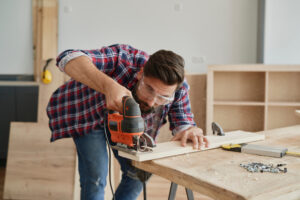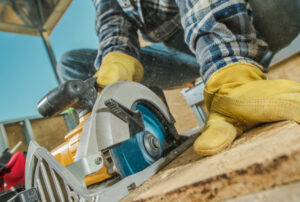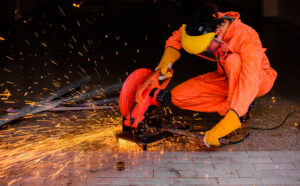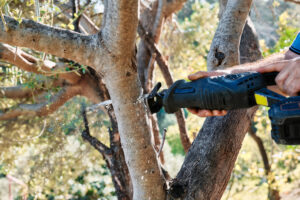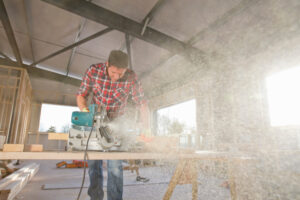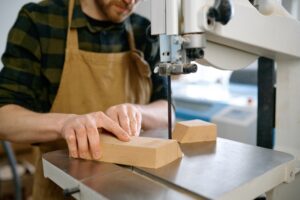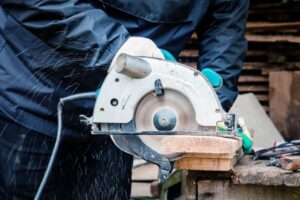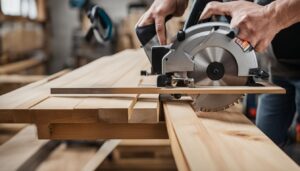Kickback is a dangerous occurrence that can happen when using a table saw. It involves the blade launching a workpiece or offcut towards the user at a high speed.
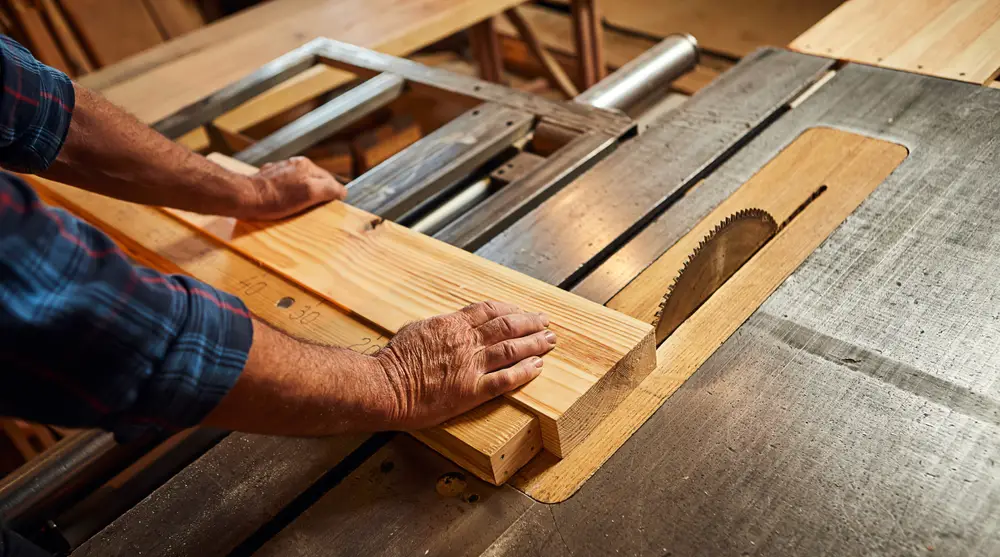
Kickback can cause serious injuries or damage. Understanding the causes of kickback and implementing the right precautions is crucial for staying safe in the workshop. In this article, I will provide a comprehensive guide on kickback prevention and safety measures when using a table saw.
Key Takeaways
- Kickback is a dangerous phenomenon that can lead to serious injuries or even hospitalization.
- Understanding the mechanics and causes of kickback is essential for effective prevention.
- Using a riving knife and anti-kickback devices can significantly reduce the risk of kickback.
- Other measures like using a crosscut sled and practicing proper stock preparation help prevent kickback.
- Avoid common mistakes such as making freehand cuts and using improper cutting techniques.
Understanding kickback on a table saw
Kickback is a dangerous phenomenon that can occur when using a table saw. It occurs when the wood being cut is propelled back towards the user at a high rate of speed. This sudden and forceful movement can result in serious injuries or even hospitalisation. To prevent kickback effectively, it is important to understand the mechanics and causes behind it.
There are several reasons why kickback can occur. One common cause is when the board being cut gets pinched between the blade and the fence. This can happen if the blade and the fence are not properly aligned or if the board is not being guided correctly. Another cause is when the board drifts over the back of the blade and gets lifted by the teeth. This can happen if the user is not applying enough pressure or if the blade is not properly aligned with the mitre slot. Additionally, kickback can also be caused by the kerf behind the blade pinching shut and binding on the blade. This can happen if the user is not providing enough support to the board or if the blade is not sharp enough.
To prevent kickback, it is essential to follow safe cutting techniques and take necessary precautions. This includes using a riving knife, which is a thin piece of metal that sits behind the blade and prevents the wood from getting caught in the back of the saw if it drifts away from the fence. Riving knives are standard on modern table saws and provide excellent kickback prevention. Additionally, using other measures such as a crosscut sled, push stick, and featherboards can further enhance safety during table saw operations. By implementing these preventive measures, woodworkers can significantly reduce the risk of kickback and ensure a safe woodworking experience.
| Kickback Causes | Preventive Measures |
|---|---|
| Board pinched between blade and fence | Apply sufficient pressure, align blade with mitre slot, use a riving knife |
| Board drifts over the back of the blade | Provide proper board support, use a sharp blade, and avoid excessive cutting force |
| Kerf behind the blade pinches shut and binds on the blade | The board drifts over the back of the blade |
Kickback Prevention Checklist
When it comes to using a table saw, kickback prevention should be your top priority. By following a few simple guidelines and precautions, you can significantly reduce the risk of kickback and ensure a safer woodworking experience. Here is a comprehensive kickback prevention checklist to help you stay safe in the workshop:
1. Use a Riving Knife:
One of the most effective ways to prevent kickback is by using a riving knife. A riving knife is a thin piece of metal that sits behind the blade and helps prevent the wood from getting caught and kicked back. It keeps the stock from pinching the back of the saw blade if it drifts away from the fence. Make sure your table saw is equipped with a riving knife and use it every time you make a cut.
2. Maintain Proper Blade Height and Fence Alignment:
Always ensure that your blade is set at the correct height and that the fence is aligned parallel to the blade. Improper blade height or misaligned fence can increase the chances of kickback. Use a square to check the blade and fence alignment regularly to ensure accuracy and safety.
3. Use Featherboards and Push Sticks:
To further enhance kickback prevention, use featherboards to hold the stock against the fence and push sticks to maintain a safe distance from the blade. Featherboards apply pressure to the stock, keeping it firmly against the fence and minimizing the risk of kickback. Push sticks allow you to guide the stock through the cut while keeping your hands at a safe distance from the blade.
4. Avoid Freehand Cuts:
When using a table saw, always use a guide or reference to make your cuts. Freehand cuts increase the chances of the stock drifting away from the fence or blade, leading to kickback. Ensure you have proper support and guidance for your cuts to maintain control and prevent kickback.
5. Keep the Table Clean and Clear:
Maintaining a clean and clutter-free table saw is essential for proper and safe operation. Remove any debris, offcuts, or potential hazards from the table before starting your cuts. A clean table allows for better control and reduces the risk of kickback.
| Kickback Prevention Checklist |
|---|
| Use a Riving Knife |
| Maintain Proper Blade Height and Fence Alignment |
| Use Featherboards and Push Sticks |
| Avoid Freehand Cuts |
| Keep the Table Clean and Clear |
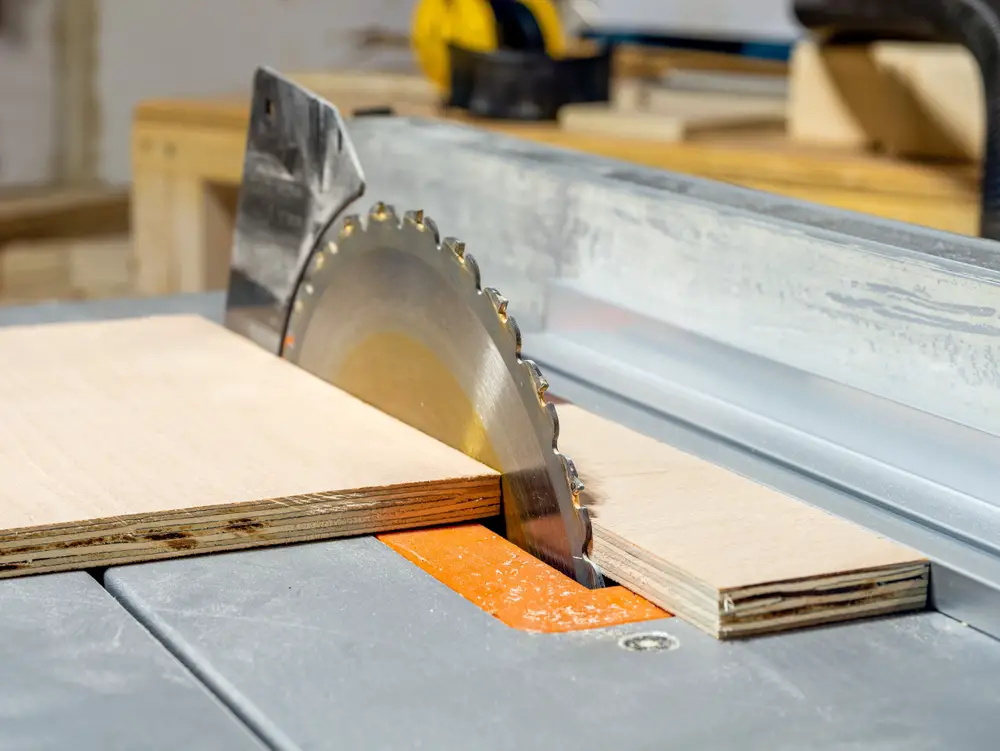
Importance of Riving Knives and Anti-Kickback Devices
When it comes to table saw safety, riving knives and anti-kickback devices play a crucial role in preventing dangerous kickback incidents. These components are designed to keep woodworkers safe by minimizing the likelihood of a workpiece being propelled back towards the user at high speeds. Let’s explore the importance of these devices and how they contribute to a safer woodworking experience.
Riving Knives
Riving knives are thin pieces of metal that are positioned behind the blade on modern table saws. Their primary function is to prevent the workpiece from getting caught in the back of the saw if it drifts away from the fence. By maintaining a slight separation between the workpiece and the blade, riving knives significantly reduce the risk of kickback.
Unlike traditional splitters, riving knives move up and down with the blade, ensuring that the space between the knife and the blade remains consistent. This feature is particularly useful when making non-through cuts or using a dado blade. By keeping the workpiece in line with the blade, riving knives effectively prevent binding and kickback, enhancing safety in the workshop.
Anti-Kickback Devices
In addition to riving knives, anti-kickback devices provide an extra layer of protection against kickback incidents. These devices are typically attached to the throat plate or splitter assembly and are designed to catch and prevent the backward movement of a workpiece.
Anti-kickback devices work by using strategically placed pawls or wheels that engage with the wood when it moves in the direction of kickback. This engagement creates a resistance that prevents the workpiece from being propelled back towards the user. By effectively countering the force of kickback, anti-kickback devices help maintain control and safety during table saw operations.
When using a table saw, it is crucial to ensure that riving knives and anti-kickback devices are properly installed and adjusted. Regular maintenance and inspections should also be performed to ensure that these safety components are in good working condition. By utilizing riving knives and anti-kickback devices, woodworkers can significantly reduce the risk of kickback and create a safer working environment.
Additional Measures to Prevent Kickback
When it comes to ensuring safety while using a table saw, there are additional measures that can be taken to prevent kickback. These measures go beyond the use of riving knives and anti-kickback devices and provide an added layer of protection. One effective method is using a crosscut sled.
A crosscut sled is a specialized jig that moves the fence to the front of the blade instead of the side. This positioning keeps the user’s hands safely away from the blade during crosscutting operations. By using a crosscut sled, the risk of kickback is significantly reduced, as the sled provides stability and control throughout the cut.
Another important tool to have when working with a table saw is a push stick. A push stick is designed to keep your hands a safe distance from the blade while guiding the workpiece through the cut. Using a push stick ensures that your hands are protected and minimizes the risk of accidental contact with the blade. Remember to always use a push stick when working with smaller stock or when your hands might come too close to the blade.
Benefits of Using a Crosscut Sled and Push Stick
Using a crosscut sled and a push stick not only enhances safety but also improves the accuracy and quality of your cuts. The crosscut sled provides a stable and controlled platform for cutting, resulting in cleaner, more precise cuts. Additionally, the use of a push stick ensures that the workpiece is fed consistently and evenly through the blade, reducing the possibility of kickback.
| Advantages of a Crosscut Sled | Advantages of a Push Stick |
|---|---|
|
|
Importance of Proper Stock Preparation
Proper stock preparation is a crucial aspect of table saw safety. Before making any cuts, it is important to ensure that the stock is properly milled and prepared. This involves checking that the stock has a square, jointed edge that can ride along the fence securely. Additionally, at least one planed face that lays flat on the table is essential for stability and accuracy during cutting.
By taking the time to properly prepare the stock, woodworkers can greatly reduce the chances of binding, kickback, and other accidents that may occur during table saw operations. Ensuring that the stock is acclimated to the shop environment for a few days prior to milling can also help minimize the risk of binding and kickback.
When the stock is prepared correctly, it promotes a safer working environment by reducing the likelihood of kickback incidents. By following these stock preparation guidelines, woodworkers can enhance their table saw safety and achieve more accurate and reliable cuts, enhancing the overall quality of their woodworking projects.
Common Mistakes to Avoid for Kickback Prevention
Kickback on a table saw can be a serious safety hazard that should be avoided at all costs. To reduce the risk of kickback and ensure table saw safety, it is important to be aware of common mistakes that can trigger kickback. By understanding and avoiding these mistakes, woodworkers can protect themselves and create a safer working environment.
Mistake 1: Making Freehand Cuts without any Guide or Reference
One of the most common mistakes that can lead to kickback is making freehand cuts without using any guide or reference. This increases the chances of the wood drifting away from the intended path and getting caught by the blade, resulting in kickback. Always use appropriate guides, such as a rip fence or a crosscut sled, to ensure accurate and controlled cuts.
Mistake 2: Using a Rip Fence for Crosscuts when the Board is Not Longer than it is Wide
Using a rip fence for crosscuts when the board is not longer than it is wide is another mistake that can trigger kickback. This can cause the wood to bind against the fence, leading to kickback. Instead, use a miter gauge or a crosscut sled to make crosscuts safely and accurately.
Mistake 3: Placing a Featherboard Past the Front of the Blade
Placing a featherboard past the front of the blade is another common mistake that should be avoided. A featherboard is a useful tool for holding the stock against the fence and preventing kickback. However, if it is positioned past the front of the blade, it can push the wood into the spinning blade, causing kickback. Always position the featherboard before the blade to ensure proper stock control and prevent kickback.
By being aware of these common mistakes and taking the necessary precautions, woodworkers can significantly reduce the risk of kickback and create a safer working environment when using a table saw. Following safe cutting techniques, using appropriate tools and guides, and prioritizing table saw safety are essential for preventing kickback and ensuring a successful woodworking experience.
Kickback Prevention Checklist
| Precaution | Description |
|---|---|
| Use a riving knife | A riving knife helps prevent kickback by keeping the wood from getting caught in the back of the saw if it drifts away from the fence. |
| Use anti-kickback devices | Anti-kickback devices, such as splitters and pawls, can further enhance kickback prevention by keeping the stock in line with the blade and preventing it from lifting. |
| Use a crosscut sled | A crosscut sled is an effective tool for making crosscuts safely, as it moves the fence to the front of the blade and keeps the user’s hands away from the blade. |
| Properly prepare the stock | Ensure that the stock is properly milled and has a square, jointed edge for riding along the fence and a planed face that lays flat on the table. |
| Allow stock to acclimate | Allow the stock to acclimate to the shop environment for a few days before milling to reduce the chances of binding and kickback. |
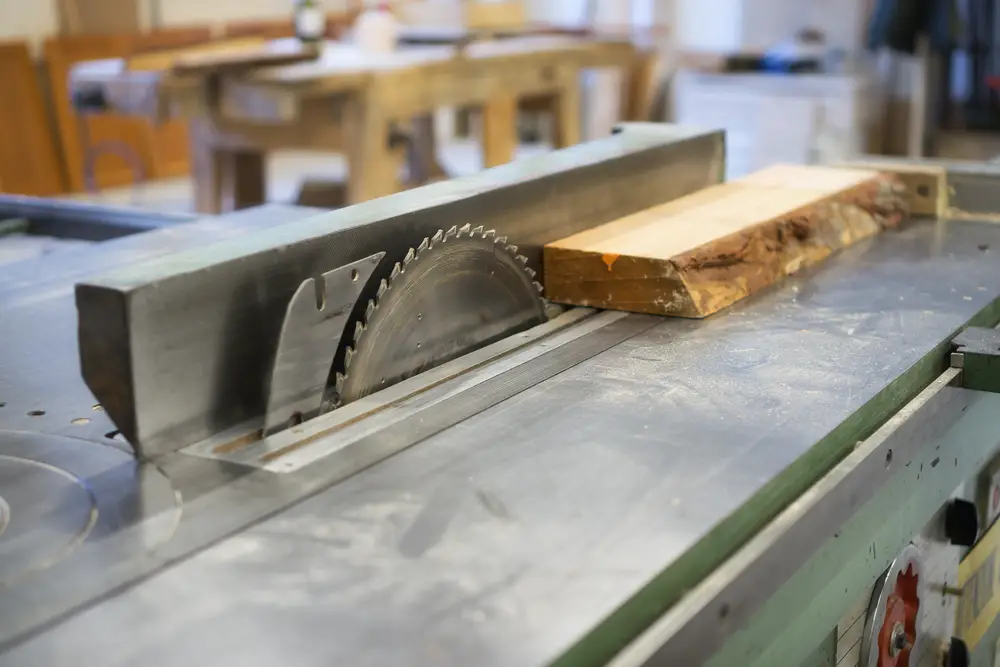
Conclusion
Kickback prevention and table saw safety are paramount when it comes to woodworking. Understanding the causes of kickback and implementing the right precautions can make all the difference in ensuring a safe and enjoyable workshop experience. By following the kickback prevention checklist, utilizing riving knives and anti-kickback devices, and practising proper cutting techniques, you can significantly reduce the risk of kickback.
Always prioritize safety and stay vigilant when operating a table saw. Remember to prepare your stock properly, ensuring it is milled and acclimated to the shop environment. Avoid common mistakes such as making freehand cuts or using improper guides. Instead, use appropriate tools like crosscut sleds and push sticks to keep your hands away from the blade and reduce the chances of kickback.
By taking these necessary precautions, you can protect yourself from the dangers of kickback and create with confidence. So, whether you’re a seasoned woodworker or just starting out, make sure you’re equipped with the knowledge and tools to prevent kickback, ensuring a safe and enjoyable woodworking journey.
FAQ
What is kickback?
Kickback is a dangerous occurrence that happens when using a table saw. It involves the blade launching a workpiece or offcut towards the user at a high speed.
Why is kickback dangerous?
Kickback can cause serious injuries or damage. Understanding its causes and implementing safety measures is crucial for staying safe in the workshop.
What causes kickback?
Kickback can happen due to various reasons, including the board getting pinched between the blade and fence, the board drifting over the back of the blade, or the kerf behind the blade pinching shut and binding on the blade.
How can kickback be prevented?
To prevent kickback, it is essential to follow certain guidelines and precautions. Using a riving knife, employing a crosscut sled, and ensuring proper stock preparation are some effective methods.
What is a riving knife?
A riving knife is a thin piece of metal that sits behind the blade and prevents the wood from getting caught in the back of the saw if it drifts away from the fence.
What are some additional measures to prevent kickback?
In addition to riving knives, using a crosscut sled and push stick can help in preventing kickback by keeping the user’s hands away from the blade and reducing the chances of kickback.
Why is proper stock preparation important for kickback prevention?
Properly milling the stock, ensuring it has a square, jointed edge for riding along the fence and at least one planed face that lays flat on the table, can reduce the chances of binding and kickback.
What are some common mistakes to avoid for kickback prevention?
Some common mistakes include making freehand cuts without any guide, using a rip fence for crosscuts when the board is not longer than it is wide, and placing a featherboard past the front of the blade.
- Drill Battery Maintenance: Essential Tips for Cordless Drill Battery Care - February 5, 2024
- Troubleshooting Drill Issues - February 5, 2024
- Quick Drilling Techniques - February 2, 2024

